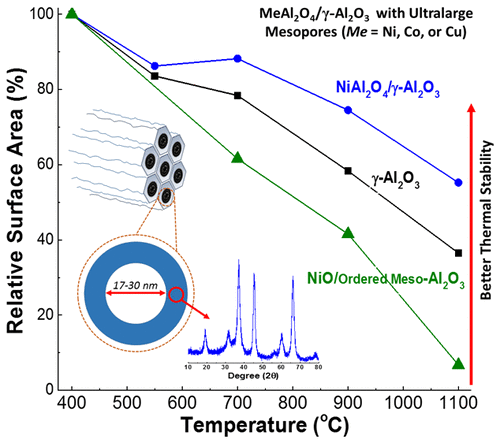当前位置:
X-MOL 学术
›
Chem. Mater.
›
论文详情
Our official English website, www.x-mol.net, welcomes your feedback! (Note: you will need to create a separate account there.)
One-Pot Synthesis of MeAl2O4 (Me = Ni, Co, or Cu) Supported on γ-Al2O3 with Ultralarge Mesopores: Enhancing Interfacial Defects in γ-Al2O3 To Facilitate the Formation of Spinel Structures at Lower Temperatures
Chemistry of Materials ( IF 8.6 ) Pub Date : 2018-01-03 00:00:00 , DOI: 10.1021/acs.chemmater.7b04353 Alexandre A. S. Gonçalves 1 , Maria J. F. Costa 1, 2 , Liping Zhang 1 , Filip Ciesielczyk 1, 3 , Mietek Jaroniec 1
Chemistry of Materials ( IF 8.6 ) Pub Date : 2018-01-03 00:00:00 , DOI: 10.1021/acs.chemmater.7b04353 Alexandre A. S. Gonçalves 1 , Maria J. F. Costa 1, 2 , Liping Zhang 1 , Filip Ciesielczyk 1, 3 , Mietek Jaroniec 1
Affiliation

|
Sintering is an important issue in creating crystalline metal oxides with high porosity and surface area, especially in the case of high-temperature materials such as metal aluminates. Herein we report a rationally designed synthesis of metal aluminates that diminishes the surface area loss due to sintering. MeAl2O4 (Me = Ni, Co or Cu) supported on γ-Al2O3 with ultralarge mesopores (up to 30 nm) was synthesized through microwave-assisted peptization of boehmite nanoparticles and their self-assembly in the presence of a triblock copolymer (Pluronic P123) and metal nitrates, followed by co-condensation and thermal treatment. The resulting materials showed the surface area up to 330 m2·g–1, porosity up to 1.6 cm3·g–1, and very good thermal stability. The observed enhancement in their thermomechanical resistance is associated with the faster formation of the metal aluminate phases. The nanometer scale path diffusion and highly defective interface of γ-alumina facilitate the counter-diffusion of Mex+ and Al3+ species and further formation of the metal aluminate phase. Additionally, it is shown that the type of transition metal affects the pore size of the nanostructured metal oxide by shifting the decomposition temperature of the triblock copolymer. Overall, the synthesis strategy requires easy steps and readily available precursors and promotes the formation of highly porous nanostructured oxides suitable for several applications such as catalysis and adsorption.
中文翻译:

餐的一锅法合成2 ö 4支持上(ME =镍,钴,或铜)的γ-Al 2 ö 3与超大的中孔:在强化界面缺陷的γ-Al 2 ö 3,以促进尖晶石结构中的较低的形成温度范围
烧结是产生具有高孔隙率和表面积的结晶金属氧化物的重要问题,尤其是在高温材料(例如金属铝酸盐)的情况下。本文中,我们报告了合理设计的金属铝酸盐合成方法,该方法可减少由于烧结引起的表面积损失。通过微波辅助的勃姆石纳米粒子的胶束合成及其在α -Al 2 O 3存在下的自组装合成了负载在γ-Al 2 O 3上的MeAl 2 O 4(Me = Ni,Co或Cu),具有较大的中孔(可达30nm)。三嵌段共聚物(Pluronic P123)和金属硝酸盐,然后进行共缩合和热处理。所得材料的表面积最大为330 m 2 ·g –1,孔隙率高达1.6 cm 3 ·g –1,并且具有非常好的热稳定性。观察到的其热机械阻力的增强与金属铝酸盐相的更快形成有关。γ-氧化铝的纳米尺度路径扩散和高缺陷界面促进了Me x +和Al 3+的反向扩散物种和金属铝酸盐相的进一步形成。另外,显示出过渡金属的类型通过改变三嵌段共聚物的分解温度而影响纳米结构金属氧化物的孔径。总的来说,合成策略需要简单的步骤和容易获得的前体,并促进了适用于多种应用(例如催化和吸附)的高度多孔纳米结构氧化物的形成。
更新日期:2018-01-03
中文翻译:

餐的一锅法合成2 ö 4支持上(ME =镍,钴,或铜)的γ-Al 2 ö 3与超大的中孔:在强化界面缺陷的γ-Al 2 ö 3,以促进尖晶石结构中的较低的形成温度范围
烧结是产生具有高孔隙率和表面积的结晶金属氧化物的重要问题,尤其是在高温材料(例如金属铝酸盐)的情况下。本文中,我们报告了合理设计的金属铝酸盐合成方法,该方法可减少由于烧结引起的表面积损失。通过微波辅助的勃姆石纳米粒子的胶束合成及其在α -Al 2 O 3存在下的自组装合成了负载在γ-Al 2 O 3上的MeAl 2 O 4(Me = Ni,Co或Cu),具有较大的中孔(可达30nm)。三嵌段共聚物(Pluronic P123)和金属硝酸盐,然后进行共缩合和热处理。所得材料的表面积最大为330 m 2 ·g –1,孔隙率高达1.6 cm 3 ·g –1,并且具有非常好的热稳定性。观察到的其热机械阻力的增强与金属铝酸盐相的更快形成有关。γ-氧化铝的纳米尺度路径扩散和高缺陷界面促进了Me x +和Al 3+的反向扩散物种和金属铝酸盐相的进一步形成。另外,显示出过渡金属的类型通过改变三嵌段共聚物的分解温度而影响纳米结构金属氧化物的孔径。总的来说,合成策略需要简单的步骤和容易获得的前体,并促进了适用于多种应用(例如催化和吸附)的高度多孔纳米结构氧化物的形成。


























 京公网安备 11010802027423号
京公网安备 11010802027423号